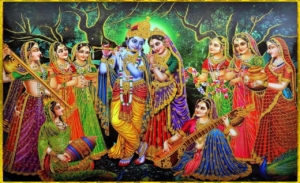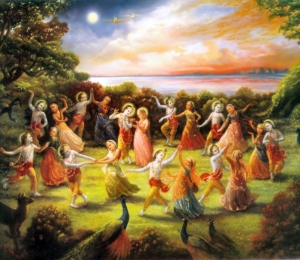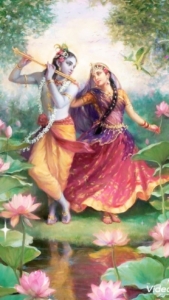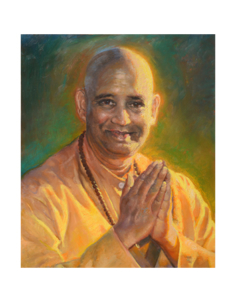Rasa Leela – The Bliss of Divine Love
 by Swami Jyotirmayananda
by Swami Jyotirmayananda
One particularly lovely night when the moon was full and the breeze was wafting the fragrance of jasmine, Lord Krishna planned to delight the gopis (cowherdesses) by sporting with them beside the Yamuna River.
Krishna then lifted His flute and played a special melody with the root letter klim—the awakener of love in the human heart. As that melody traveled through the wind, it delighted the hearts of the gopis and they became completely overwhelmed by it. Forgetting whatever they were doing at the time, they were drawn to that irresistible sound.
Gopis who were milking their cows just dropped their buckets and ran to find Krishna. Those who had milk boiling on the fire left it bubbling. Those who were cooking pudding left the pudding half done. Those who were serving food to their relatives dropped their vessels and ran. Mothers left their children and wives left their husbands, and all ran swiftly to the source of that wondrous melody. Those who were restricted from leaving by their relatives secluded themselves behind closed doors and united themselves with Krishna in meditation, like rivers flowing to the ocean.
When the gopis assembled before him, Krishna wanted to test the sublimity of their devotion. Thus, he said, “Why have you left your homes? Why are you not true to your own husbands? Why do you seek me out as your beloved? You should all go home.”
The gopis were surprised when they heard Krishna speaking in that way, and they responded with words that proved their awareness of his glory and majesty. Their expressions made it clear that they loved him not as an ordinary person, but as the Self that abides in all.
In response to the purity of their souls, Krishna then sported with all the gopis by the Yamuna River, assuming numerous forms, delighting each one of them, as if he were there for each one individually. As a result, however, the women developed a sense of subtle pride, feeling that they were the best of women in the whole world since they had captured the beloved of all. When Krishna saw that they had developed that pride, he suddenly disappeared.
Overcome with grief at Krishna’s disappearance, the gopis began to look for Krishna everywhere, asking every tree, every creeper, every flower if they knew where Krishna had hidden himself. Filled with a terrible pain of separation, they began recalling all the details of their joyous sporting with Krishna, all his mannerisms and actions, all the heroic deeds that characterized his childhood.
As they continued searching, they discovered at one place along their way the footprints of their beloved. Along with the footprints of Krishna were the footprints of a gopi, whom they concluded had secretly gone away with Krishna (The later Puranic writers identify this gopi as Radha).
In despair because they could not find Krishna anywhere, the gopis poured out their hearts in song in praise of their beloved, a song referred to as Gopika Gita, which is written in most melodious Sanskrit. Because of the purity with which they expressed their yearning, Krishna appeared before them again, smiling gently. He was a mass of beauty with yellow apparel decking his body and the forest flowers forming a garland on his neck.
The moment they saw the beautiful form of Krishna, the gopis entered into ecstasy, filled with joy. Overwhelmed by their sublime devotion, Krishna explained that he had disappeared briefly only to help remove certain limitation within their heart and to encourage their love to flow on more steadily to perfection.
Then, with the gopis free of any defect in their love, Krishna revealed himself in as many forms as there were cowherdesses. By the shimmering sands of the moonlit Yamuna River, they formed a splendid circle of Divine Love, with one manifestation of Krishna between every two gopis, dancing with arms entwined. This sublime dance was witnessed by countless deities from the celestial realm who had crowded the sky, enjoying the radiation of intense joy as Krishna danced with these purest of devotees.
When morning approached, the gopis returned to their homes with profound contentment. Due to the magic of Krishna’s Maya, their families did not feel that they had been away at all.
***
 This portion of Srimad Bhagavatam that describes the rasa leela or dance of Krishna with the gopis is one of the most poetic portrayals of Divine communion to be found in bhakti (devotional) literature. It is an attempt to express in words and images the highest Bliss, Bhuma, that a devotee experiences. This magnificent painting of a wondrous dance in the forest of Vrindabana is actually a painting of what occurs within the human heart in the state of Divine communion.
This portion of Srimad Bhagavatam that describes the rasa leela or dance of Krishna with the gopis is one of the most poetic portrayals of Divine communion to be found in bhakti (devotional) literature. It is an attempt to express in words and images the highest Bliss, Bhuma, that a devotee experiences. This magnificent painting of a wondrous dance in the forest of Vrindabana is actually a painting of what occurs within the human heart in the state of Divine communion.
Your chitta (heart or deep unconscious) becomes clear as the autumn sky. The mind, free of all selfish desires and impurities, shines like the full moon, radiating the beauty of the Self. A deep feeling of Divine Love surges like the Yamuna River. At that moment of perfection, the melody of eternity that vibrates from the flute of Krishna or the Divine Self within can be heard with total clarity. Then all your Divine sentiments, represented by the gopis, flow to the Divine Self—the embodiment of Love and Bliss—in a thrilling dance of Divine communion.
The “Last Judgment” Portrayed in the Language of Love
Although the melody of Krishna is always there, the soul does not hear it due to ignorance. However, when there is purity of heart and mind, you become aware of the melody of eternity that transcends all, and it transforms your existence.
Such awareness can come to you at any moment, whether you are engaged in busily serving others or seated in meditation, whether it is night or day, whether you are walking or sitting. The Divine experience does not depend upon any external situation, nor does it knock upon your door and wait for you to invite it in. That experience comes all of a sudden, like a lightning flash.
This same point has been brought out in the Bible in the description of the Last Judgment. Lord Jesus speaks about a Last Judgment that can come suddenly at any time, without giving a person prior warning. If you are on the rooftop, there will be no time to come down.
This biblical portrayal of the Last Judgment sometimes evokes in the ignorant mind a feeling of tremendous terror, a fear of the coming of a great calamity. However, Jesus was merely implying that at the moment of Enlightenment the whole world of relativity is pierced by a transcendental understanding. In Srimad Bhagavatam, that Last Judgment is portrayed in the language of love as the rasa leela, in which the whole world becomes transfigured into a Divine dance. In this dance you experience the shattering of all illusions and face the ultimate truth—which is all Love, all Bliss.
The Magnetic Pull of Divine Bliss
In the Upanishads, God is described as rasa, which literally means nectarine taste. The world abounds with experiences that the human senses find extremely delightful. Yet the source of all those nectarine delights is the Divine Self.
As you advance on the path of devotion you feel a joyous movement towards God. You feel that mighty magnet of God drawing your soul beyond the pull of everything else in the world. Like the gopis, you will leave all relative realities behind and run as fast as you can to the arms of the Divine Beloved.
Divine Love has been compared to the emotional compound of three forms of love: a miser’s overwhelming craving for gold, a mother’s all-consuming awareness of her child, a lover’s total fascination with his beloved. Compounding all three together will give you some limited idea of Divine Love. If any one of the three could make a person “mad,” all three together are bound to make one “super mad,” with the mind overwhelmed beyond imagination.
Divine Love and Worldly Love
 The devotional language and imagery that is used to portray the relationship between Krishna and the gopis in Srimad Bhagavatam is the language of human love between a lover and beloved. This same technique has been used extensively in the Sufi literature of the Middle East as well as in the Bible in the poetic Song of Solomon. That language portrays the soul as a lover longing for his beloved or rejoicing in the presence of his beloved—but it is highly symbolic and points to a state of purity that transcends all human limitations in love. The imagery was selected as the best language that could be used to direct the human mind to the profound and verbally indescribable experience of Bliss that is possible when the soul unites with God.
The devotional language and imagery that is used to portray the relationship between Krishna and the gopis in Srimad Bhagavatam is the language of human love between a lover and beloved. This same technique has been used extensively in the Sufi literature of the Middle East as well as in the Bible in the poetic Song of Solomon. That language portrays the soul as a lover longing for his beloved or rejoicing in the presence of his beloved—but it is highly symbolic and points to a state of purity that transcends all human limitations in love. The imagery was selected as the best language that could be used to direct the human mind to the profound and verbally indescribable experience of Bliss that is possible when the soul unites with God.
The experience of love between lover and beloved is characterized by all-consuming, one-pointed longing that causes one to lose awareness of normal reality. If this is so for worldly love, how much more intense should be the experience of communion with the Divine Beloved? This is pointed out so colorfully in a Sufi parable:
Once during the evening hours, a Sufi Saint was seated on his special prayer rug, practicing meditation on God. Suddenly, a young lady who was going secretly to meet her lover ran across the rug, accidentally dirtying it with her feet in the excitement of her project. Seeing this, the Saint shouted at her, “Are you blind? How could you defile my sacred prayer rug?”
The young lady turned towards him, saying, “Sir, please forgive me. I am blinded by thoughts of my lover, and therefore I could see only him. But please tell me, why is it that your love for God has not made you more blind than I am? You are seeing me and your prayer rug and my flight through the forest—everything but God! What kind of love is that?” Hearing these words, the Saint was humbled.
Since the Divine Love of the gopis is portrayed in the amorous language of worldly love, it occasionally gives rise to various forms of confused interpretations. An uncultured mind tainted by the illusions of passion is unable to understand the lofty heights of devotional sentiment so poetically presented by the Sages who composed the scriptures of devotion.
A devotee does not love God the same way deluded souls love objects of the world. Madhurya bhava, or a devotee’s sweet love for God, is the positive counterpart of the intense passionate love that exists in the world. In worldly love, the mind is clouded by passionate illusion and the light of reason becomes dim. In Divine Love, however, the mind is unclouded, and the light of reason shines brighter and brighter until it blooms into the Divine Light of intuition.
Radha—The Symbol of Mahabhava
 The highest flight of devotional sentiment is called mahabhava in mystical terminology. In certain devotional Puranas, this absolutely pure sentiment is symbolized by Radha, the foremost devotee among the gopis. Although Srimad Bhagavatam does not mention the role of Radha, it does suggest that there was one among the gopis who was especially close to Krishna. In the later Puranas, Radha became the symbol of the highest devotional feeling.
The highest flight of devotional sentiment is called mahabhava in mystical terminology. In certain devotional Puranas, this absolutely pure sentiment is symbolized by Radha, the foremost devotee among the gopis. Although Srimad Bhagavatam does not mention the role of Radha, it does suggest that there was one among the gopis who was especially close to Krishna. In the later Puranas, Radha became the symbol of the highest devotional feeling.
In these texts, there is no jealousy between the gopis and Radha, just as there is no contradiction between Divine sentiments and the highest devotional feeling, mahabhava, in which all sentiments are fulfilled. Thus, the gopis yearned to bring Radha and Krishna together. They found their love for Krishna fulfilled as Radha met with Krishna and delighted in Him. They experienced Divine satisfaction in Krishna’s one-pointed love for Radha and Radha’s love for Him. The moment Radha unfolds within one’s heart, union with Krishna naturally follows. When one finds the “footprints” of mahabhava, they will lead one directly to the Divine Self!


